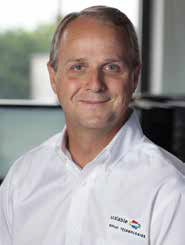Quick Bio
Name: Andrew Jamison
Title: CEO
Company: Scalable Display Technologies
Overtime: It was Radio Shack’s 150-in-One Electronic Project Kit in the third grade that had Jamison hooked on AV. It was like the first 4K, 60,000-lumen projector to him.
SCN: When did you realize you were destined for a career in technology?
Andrew Jamison: Although I did not know it at the time, nor am I proud to admit it now, Radio Shack changed the direction of my life. It was the 150-in-One Electronic Project Kit in the third grade that did me in. I connected those colored wires with the springs to build things like a basic light circuit, which in my mind, was the first 4K, 60,000-lumen projector.
In seventh grade, those early feats of engineering were followed by the Heathkit IM-11 vacuum tube voltmeter. This project gave me a dose of reality, because the kit contained an “undocumented feature” in the form of a bad capacitor, which caused the whole device to malfunction. After many hours of professional diagnostics by engineers at Dictaphone, I was up and running.
SCN: You were the fourth employee at PictureTel, one of the first videoconferencing companies, which was eventually acquired by Polycom. How did such success with a startup at the launch of your career inform your business acumen?
AJ: The first lesson: hard work does in fact pay off. While it sounds clichéd, it proved to be true in my experience. Were it not for the hard work of the initial team in the early days, the history of the videoconferencing market would very likely look different.
The second lesson: that small, lightly funded start-ups don’t move markets. No matter how much we love our technology and spend money to promote it, the key to success is to partner up with industry giants that beat a loud drum. It is ideal to offer a technology that helps sell the behemoths’ goods or services. In the case of PictureTel, it was AT&T that was trying to sell ISDN services.
A third lesson: MIT startups tend to lead the market by many years, sometimes 10 or 15 years. The actionable lesson is to refer back to lessons one and two, there are pre-requisites to success, so plan to run a marathon, and don’t run out of money while the market develops to catch up with you.
Lesson four: Reputation is everything. When you are in the game for the long haul, it is critical that you have a customer-centric culture that naturally develops customers as friends and advocates. PictureTel was a startup 30 years ago, and there is still a strong affinity among the early pioneering customers.
SCN: Before joining Scalable Display Technologies, you experienced your share of startups and acquisitions. How did those unique experiences foster your management style?
AJ: I have been very fortunate to work with excellent teams of individuals over the years. My “early-stage” company experiences have highlighted the importance of teams and teamwork. In my personal experience, one of the greatest under-appreciated and under-nurtured assets of any small (and potentially large) company is the organizational health of the team. The benefits of a healthy team are multiplicative, while the downside can be catastrophic to a young company.
SCN: Through your experience at various software-based companies, how do you view the AV industry’s transition from hardware- to software-centric systems?
Andrew Jamison is an avid mountain biker, and he spends much of his free time exploring the trails in his area. AJ: I think that I have a reasonably good vantage point from which to reflect on this question. Consider that in 1986, I was selling a “box” for video compression-decompression (codec) for $75,000 each. These boxes resembled two-drawer file cabinets and used 1,500 watts of power. Twenty-five years later, that capability was found in the iPhone, and today, it can be matched by a Raspberry Pi for $25. Yes, the transition is real.

The AV industry understands the risks well: hardware is getting cheaper, interconnectivity is moving toward IP, and traditional AV skills-sets do not typically include IT networking. Many conclude that AV is doomed, but I think otherwise. I see great confusion in the market today and for years to come. As the old adage says: “where there is confusion there is opportunity.”
We have many competing standards in many different aspects of our industry. By way of example: the battle between IEEE AVB/TSN versus individual “commercial standards;” SMPTE 2022, and ITU standards. All of these conflicting forces present opportunities for systems integrators to educate customers on the market dynamics.
We also have a wonderful confluence of new technology that will drive the need for new displays. The recent resurgence of VR as evidenced by Oculus and Google Cardboard is driving a new type of content. The new content is prospectively correct 360-degree imagery that is designed for immersive viewing. Fortunately, most customers would rather not wear head-mounted devices, and this opens up substantial opportunity. The opportunity is for direct-view VR on immersive dome screens, much like an IMAX or Disney experience.
Lastly, technology has taken us to a point where the displays can become simple devices at the end of the network. This has been referred to as the “Internet of Display.” With big data, online games, and VR generating content from the cloud, the display can be brought to life and used in large arrays to create new and exciting environments.
All and all, this is an especially good time for the practice of consultative selling. You don’t need to be clairvoyant to know that a sea change is underway. You do, however, need to be very attentive to understand the telltale information that is available to help make recommendations to customers based on that informed perspective.
SCN: What kind of a company culture have you looked to instill at Scalable, and how do you view that alongside the culture of the AV industry as a whole?
AJ: I love the AV industry. Having worked in other industries over the years, I like AV the best. I find the culture to be professional and ethical, and the people to be great. It is wonderful to have many longtime friends in our industry.
As far as culture at Scalable, I hope that our actions demonstrate that customer support is our top priority. We have a “leave no customer behind” mindset. At the same time, we take a very firm posture on making sure that every opportunity we pursue is well vetted. We ask lots and lots of questions to help our integration partners thoroughly qualify a system’s design before we get to the PO stage. Sometimes we qualify deals so fully that we feel like the “order-prevention department,” but we would rather not have an order unless it produces a customer that is happy and an advocate.
Lindsey M. Adler is editor of SCN.

